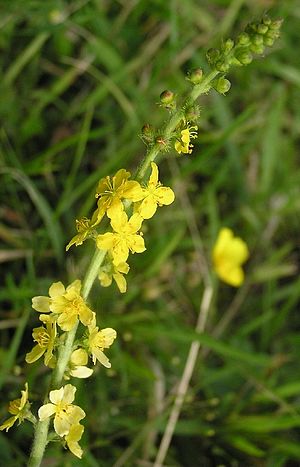Note: This is a project under development. The articles on this wiki are just being initiated and broadly incomplete. You can Help creating new pages.
Difference between revisions of "Agrimonia eupatoria - Agrimony"
Chaithrika (talk | contribs) (+common name) |
Chaithrika (talk | contribs) m (Chaithrika moved page Agrimony to Agrimonia eupatoria: Renaming as per convention) |
(No difference)
| |
Revision as of 11:41, 10 March 2017
Agrimony is a species of agrimony that is often referred to as Agrimonia eupatoria, church steeples or sticklewort.
The whole plant is dark green with numerous soft hairs. The soft hairs aid in the plant's seed pods sticking to any animal or person coming in contact with the plant. The flower spikes have a spicy odor like apricots. In the Language of Flowers Agrimony means thankfulness or gratitude.
Description
The common agrimony grows as a deciduous, perennial herbaceous plant and reached heights of up to 100 cm (39 in). Its roots are deep rhizomes, from which spring the stems. It is characterized by its typical serrated edged pinnate leaves.[1]
The short-stemmed flowers appear from June to September, in long, spike-like, racemose inflorescences.
Uses
- Agrimony has been stated to have medical and magical properties since the time of Pliny the Elder. It is ruled astrologically by Cancer, according to Nicholas Culpeper. Common folklore held that it could cure musket wounds and ward off witchcraft.[clarification needed]
- Traditional British folklore states that if a sprig of the plant was placed under a person's head, they would sleep until it was removed.
- It cure coughs, skin eruptions and cystitis[2]
- It is mainly used as a gastro-intestinal tonic.[2]
common name
- English - Common agrimony
